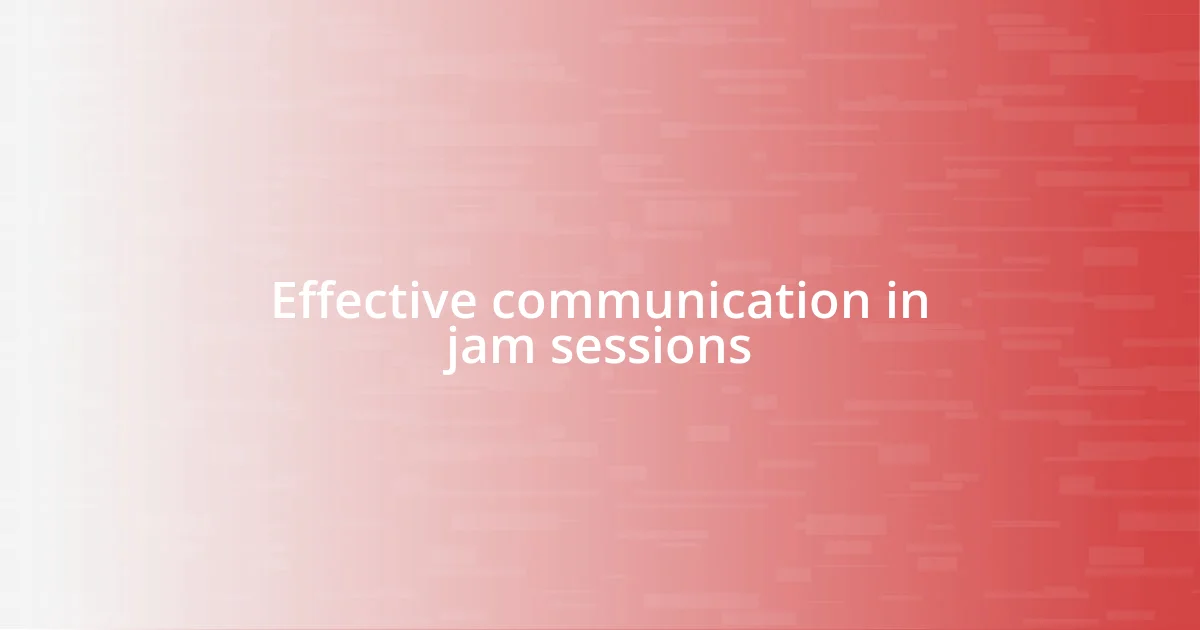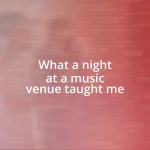Key takeaways:
- Community jam sessions foster connection and creativity, encouraging participants to collaborate and share diverse musical styles.
- Effective communication, including non-verbal cues and active listening, is crucial for a supportive and harmonious jam session environment.
- Overcoming challenges, such as clashing styles or quiet participants, can be addressed through techniques like deep breathing, showcasing individual strengths, and providing encouragement.

Understanding community jam sessions
Community jam sessions are vibrant gatherings where creativity thrives. The energy during these sessions is contagious, pulling everyone into a shared space of musical expression. I remember my first jam session; the nerves I felt quickly melted away as new friendships formed over spontaneous melodies. Isn’t it incredible how music can bridge gaps between strangers?
These sessions aren’t just about playing music; they’re about connection and collaboration. Each participant brings their own stories and experiences to the mix, creating a unique tapestry of sounds. I’ve found that the most unexpected collaborations can lead to the most memorable performances. Have you ever played alongside someone whose style was completely different from yours? It opens up a world of possibilities.
Moreover, the beauty of community jam sessions lies in their inclusivity. Everyone is welcome, regardless of skill level. I once met a seasoned musician who eagerly offered guidance to a nervous beginner. That moment highlighted the importance of encouragement and shared learning. How often do we get the chance to learn and grow alongside others in such an open environment?

Effective communication in jam sessions
Effective communication during jam sessions is essential for creating a supportive atmosphere. I remember a particular session where one member struggled to express their ideas verbally. Instead of letting that become a barrier, we utilized gestures and even quick sketches on a notepad. This approach bridged the gap and allowed for a seamless flow of creativity. It’s fascinating how non-verbal cues can amplify our musical conversations, isn’t it?
Listening actively is another cornerstone of effective communication in these sessions. There was this one time when a soloist picked up on an underlying rhythm that the rest of us hadn’t noticed. By tuning in closely, we all adjusted our playing, and this synchronicity made the performance resonate deeply with everyone present. That moment reinforced the idea that truly engaging with each other’s contributions can elevate our collective sound in profound ways.
Lastly, clarity in expressing musical ideas cannot be understated. I’ve encountered countless times where I’ve had to simplify complex riffs for fellow musicians. When I share what I hear in my mind without overthinking it, I notice everyone can quickly grasp the idea and run with it. It’s not just about clear communication but fostering an environment where everyone feels confident to share their thoughts, allowing us all to shine together.
| Communication Aspect | Description |
|---|---|
| Non-verbal Cues | Using gestures and sketches to express musical ideas when words fall short. |
| Active Listening | Tuning into each other’s contributions to create a more cohesive performance. |
| Clarity in Expression | Simplifying ideas to ensure everyone understands and can participate effectively. |

Techniques to enhance musical collaboration
Techniques to enhance musical collaboration can truly elevate the jam session experience. I remember a time when we decided to establish a “musical call-and-response” routine. It was simple yet powerful; one musician would play a phrase, and we would all echo it back. This technique not only encouraged everyone to participate but also allowed us to build on each other’s ideas organically, creating a shared sound that felt both collective and unique. It’s a technique that brings an infectious spirit of playfulness to the session, making it easier for everyone to jump in.
To further enhance collaboration, consider the following techniques:
– Rotate Leadership: Allow different musicians to take turns leading the jam. This empowers everyone and promotes diverse musical styles.
– Themed Sessions: Choose a specific genre or mood for each jam. This can guide your collective creativity and inspire new interpretations.
– Silent Jams: Spend a few moments playing without any discussion. This silent approach drives a deeper connection as musicians rely solely on intuition and connection to one another.
– Collaborative Songwriting: Create a song together on the spot. One line can become a chorus, leading to unexpected harmony and lyricism.
– Feedback Sessions: Dedicate a few minutes after playing to share thoughts and impressions. This encourages growth and understanding among participants, making future jam sessions even more fulfilling.
These approaches have transformed my jam sessions into vibrant explorations of creativity. Trust me, once you integrate these techniques, you might just find the collaborative spirit reaching new heights!

Overcoming challenges in jam sessions
Sometimes, challenges arise in jam sessions, and I’ve learned to approach them with an open mind. I recall a moment when the ensemble struggled to stay in rhythm. Instead of letting frustration brew, we took a quick break. During that pause, I suggested we all take a few deep breaths together. Surprisingly, not only did we regain our focus, but the shared moment created a sense of unity that carried us through the rest of the session. Have you ever noticed how simply stepping back can clear the air and reset the vibe?
Another hurdle I’ve faced is clashing musical styles. There was this time when we had musicians from vastly different backgrounds—one was a jazz enthusiast while another was deeply rooted in rock. To bridge the gap, I encouraged everyone to play their signature style briefly, allowing us to appreciate each other’s strengths. That exchange not only educated us but also sparked some innovative fusions that surprised us all. Isn’t it amazing how embracing differences can lead to the most unexpected collaborations?
Lastly, dealing with quiet players can sometimes make it hard to hear everyone’s contributions. I remember a session where one talented guitarist was hesitant to share his ideas. I chose to spotlight him by asking him to lead us into a section of the song. As he played, his confidence blossomed, and soon he was adding layers we never previously imagined. It’s incredible how a little encouragement can inspire someone to open up and share their creativity, don’t you think?















